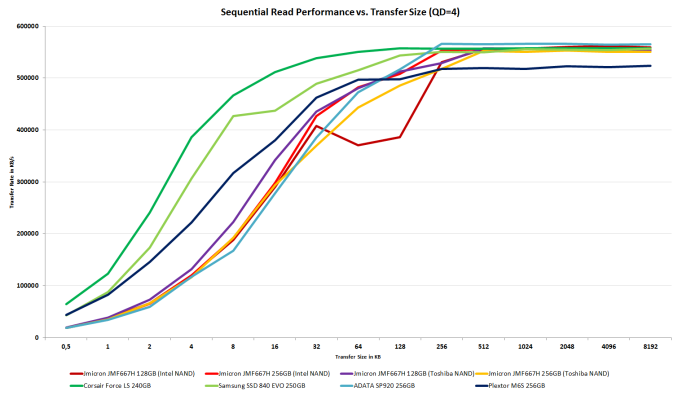JMicron JMF667H Reference Design (128GB & 256GB) Review
by Kristian Vättö on May 29, 2014 9:00 AM ESTPerformance vs. Transfer Size
ATTO is a useful tool for quickly benchmarking performance across various transfer sizes. You can get the complete data set in Bench. Read performance is very similar to the ADATA SP920, which isn't a terrible thing but as you can see there are better SSDs. I'm surprised that there isn't really any boost from Toshiba NAND, although I'm guessing this is more of a controller bottleneck than a NAND one since reading from NAND is much faster than writing in the first place.
As for write performance, it's not top notch at the bigger IO sizes but the performance scales pretty well before reaching its limit. Now the NAND shows a major role as the the drives equipped with Toshiba's 64Gbit NAND perform much better than their IMFT counterparts.
Click for full size












28 Comments
View All Comments
mflood - Thursday, May 29, 2014 - link
Looks like a great product for last year. This might help JMicron capture some of the OEM market - maybe even some budget enthusiast SSDs. What JMicron didn't do was swoop in with a M2 x4 PCIExpress controller. I'm done with 6Gbps SATA.romrunning - Thursday, May 29, 2014 - link
Ahhhh.... JMicron - like a phoenix from the ashes. Fool me once, shame on you. Fool me twice...Oh well, someone has to be at the bottom of the barrel.
romrunning - Thursday, May 29, 2014 - link
I guess their selling point would be that they're cheaper than the Crucial M500. So if pricing is all-important to you (and why are you buying a SSD if price is all-important), then they would be a contender.The_Assimilator - Thursday, May 29, 2014 - link
Please stop insulting barrels.moridinga - Thursday, May 29, 2014 - link
"The JMF667H is not perfect and there are a couple of things I would like to see. The first one is support for TCG Opal 2.0 and IEEE-1667 encryption standards."IEEE-1667 is not an encryption standard. Perhaps you meant IEEE-1619
Kristian Vättö - Thursday, May 29, 2014 - link
Nope. IEEE-1667 is for storage devices, at least the version I'm looking at.http://www.ieee1667.com/download/informational-doc...
moridinga - Friday, May 30, 2014 - link
Yes, it is authentication and discovery for storage devices (particularly removable/portable ones). It says nothing about encryption.Gigaplex - Saturday, May 31, 2014 - link
IEEE-1667 is a requirement for Microsofts Bitlocker eDrive, which is encryption.KAlmquist - Thursday, May 29, 2014 - link
Contrary to the history given in the introduction, it was with the the Indilinx "barefoot" controller that was the game changer. Once Indrilinx entered the market, SSD's based on the J-Micron controller could only be sold to consumers who didn't understand what they were buying. The name J-Micron became toxic because if you wanted to advise somebody on buying an SSD, your first and last words would be, "whatever you do, don't buy and SSD with a J-Micron controller."In contrast, Sandforce's first generation controller was an incremental improvement over what came before it. There's nothing wrong with that, but the term "game changer" doesn't apply.
HisDivineOrder - Thursday, May 29, 2014 - link
Seems like that early history explanation really misses the point that Indilinx was the first real competition to Intel back then.Sandforce came along and was the first company to put Intel down. But Indilinx was the first company that convinced people they could live with non-Intel SSD's and not... be JMicron'ed.